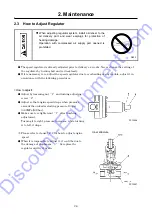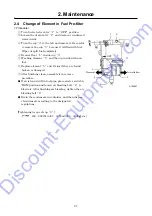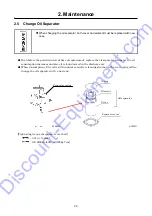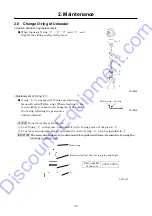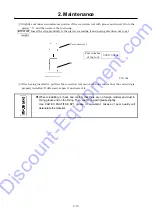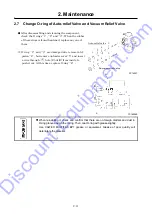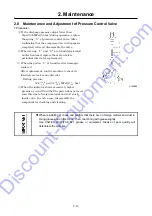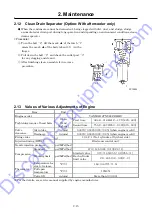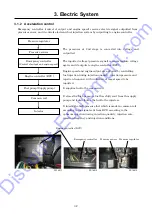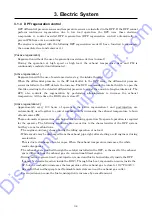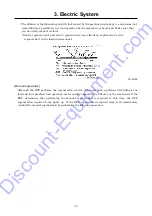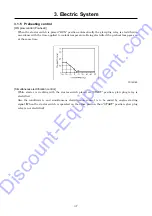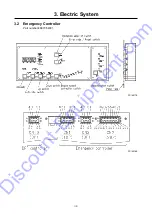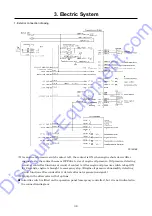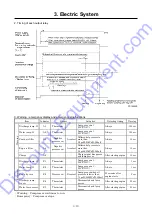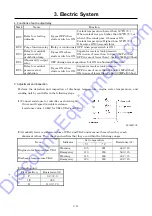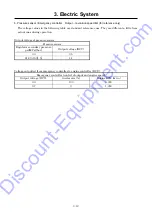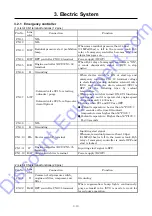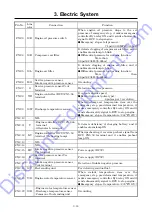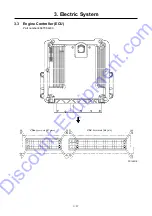
3. Electric System
3-4
3.1.4
DPF regeneration control
DPF differential pressure sensor and temperature sensor are installed in the DPF. If the DPF cannot
perform continuous regeneration due to low load operation, the ECU uses these electrical
components to control assisted DPF regeneration (DPF regeneration control) automatically to
prevent PM from over-accumulating.
The engine is equipped with the following DPF regeneration mode (It has a function to regenerate
the accumulated soot and removes it.).
[Passive regeneration]
Regeneration without the use of regeneration assistance devices (normal)
During the operation at high speed or high load, the exhaust temperature rises and PM is
continuously combusted and eliminated.
[Active regeneration-1]
Regeneration with the use of assistance devices (e.g. the intake throttle)
When the differential pressure in the SF inlet/outlet in the DPF rises, the differential pressure
sensor installed to the DPF detects the increase. The ECU commands the intake throttle to open the
throttle according to the detected differential pressure to adjust the amount of engine intake air. The
ECU also controls the regeneration by performing after-injection to increase the exhaust
temperature. At this time, the EGR valve is closed.
[Active regeneration-2]
Approximately every 100 hours of operation, the active regeneration-1 and post-injection are
automatically used together to control regeneration by increasing the exhaust temperature to burn
off and remove PM.
These automatic regenerations can be performed during operation. No special operation is required
for the operator. The following conditions may occur due to the characteristics of the DPF system,
but they are not malfunctions.
・
The engine sound may change during the idling operation at no load.
・
White smoke may be discharged from the exhaust pipe right after starting a cold engine or during
acceleration.
This is due to discharge of water vapor. When the exhaust temperature increases, the white
smoke disappears.
・
The exhaust gas is purified through the catalyst installed in the DPF, so the smell of the exhaust
gas is different from the exhaust gas of a conventional diesel engine.
・
During active regeneration-2, post-injection is used and fuel is burned directly inside the DPF
(burned by chemical reaction inside the DOC). Through this heat, regeneration occurs inside the
SF, but the combustion increases the temperature of the exhaust gas to close to 1112°F (600
℃
).
Be careful that neither people nor flammable materials are near the exhaust gas outlet.
・
Post-injection can cause the fuel consumption to increase by a small amount.
Discount-Equipment.com
Summary of Contents for PDS185S-6E1
Page 1: ...www discount equipment com D i s c o u n t E q u i p m e n t c o m...
Page 10: ...1 Specification 1 4 Unit mm A131025 D i s c o u n t E q u i p m e n t c o m...
Page 18: ...1 Specification 1 12 1 7 Piping Diagram PC14063E D i s c o u n t E q u i p m e n t c o m...
Page 19: ...1 Specification 1 13 1 8 Fuel Piping PC14001 D i s c o u n t E q u i p m e n t c o m...


